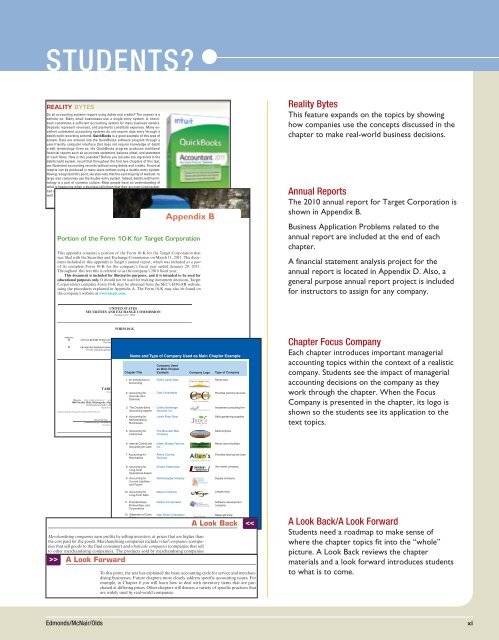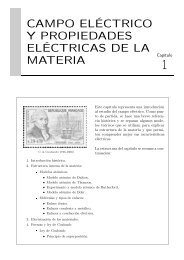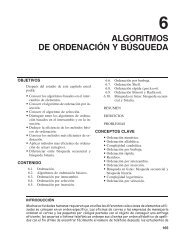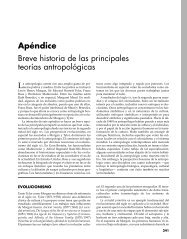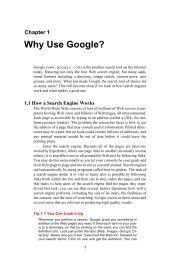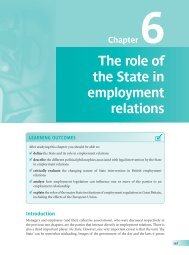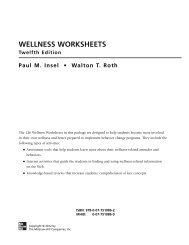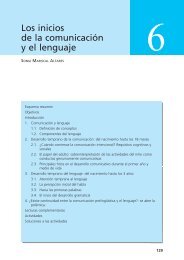Fundamental Financial Accounting Concepts - Novella - McGraw-Hill
Fundamental Financial Accounting Concepts - Novella - McGraw-Hill
Fundamental Financial Accounting Concepts - Novella - McGraw-Hill
You also want an ePaper? Increase the reach of your titles
YUMPU automatically turns print PDFs into web optimized ePapers that Google loves.
STUDENTS?<br />
edm25362_ch03_138-205.indd Page 151 8/19/11 9:08 AM user-f494 /Volume/202/MHBR249/hiL29244_disk1of1/0078029244/hiL29244_pagefiles<br />
REALITY BYTES<br />
Do all accounting systems require using debits and credits? The answer is a<br />
definite no. Many small businesses use a single-entry system. A checkbook<br />
constitutes a sufficient accounting system for many business owners.<br />
Deposits represent revenues, and payments constitute expenses. Many excellent<br />
automated accounting systems do not require data entry through a<br />
debit/credit recording scheme. QuickBooks is a good example of this type of<br />
system. Data are entered into the QuickBooks software program through a<br />
user-friendly computer interface that does not require knowledge of debit/<br />
credit terminology. Even so, the QuickBooks program produces traditional<br />
financial reports such as an income statement, balance sheet, and statement<br />
of cash flows. How is this possible? Before you become too ingrained in the<br />
debit/credit system, recall that throughout the first two chapters of this text,<br />
we illustrated accounting records without using debits and credits. <strong>Financial</strong><br />
reports can be produced in many ways without using a double-entry system.<br />
Having recognized this point, we also note that the vast majority of medium- to<br />
edm25362_appb_697-753.indd large-size companies Page use 697 the 03/10/11 double-entry 4:45 PM system. user-f501 Indeed, debit/credit termi-<br />
/207/MHBR245/edm25362_disk1of1/0078025362/edm25362_pagefiles<br />
nology is a part of common culture. Most people have an understanding of<br />
what is happening when a business tells them that their account is being debited<br />
or credited. It is important for you to embrace the double-entry system as<br />
well as other financial reporting systems.<br />
Appendix B<br />
Portion of the Form 10-K for Target Corporation<br />
This appendix contains a portion of the Form 10-K for the Target Corporation that<br />
was filed with the Securities and Exchange Commission on March 11, 2011. The docu-<br />
edm25362_ch04_206-267.indd Page 231 8/19/11 11:44 AM user-f501 /207/MHBR245/edm25362_disk1of1/0078025362/edm25362_pagefiles<br />
ment included in this appendix is Target’s annual report, which was included as a part<br />
of its complete Form 10-K for the company’s fiscal year ended January 29, 2011.<br />
Throughout this text this is referred to as the company’s 2010 fiscal year.<br />
This document is included for illustrative purposes, and it is intended to be used for<br />
educational purposes only. It should not be used for making investment decisions. Target<br />
Corporation’s complete Form 10-K may be obtained from the SEC’s EDGAR website,<br />
using the procedures explained in Appendix A. The Form 10-K may also be found on<br />
the company’s website at www.target.com.<br />
UNITED STATES<br />
SECURITIES AND EXCHANGE COMMISSION<br />
Washington, D.C. 20549<br />
FORM 10-K<br />
2/11 12:47 PM user-f501 /207/MHBR245/edm25362_disk1of1/0078025362/edm25362_pagefiles<br />
(Mark One)<br />
� ANNUAL REPORT PURSUANT TO SECTION 13 OR 15(d) OF THE SECURITIES EXCHANGE ACT OF 1934<br />
edm25362_ch04_206-267.indd Page 232 8/28/11 For the fiscal year 11:02 ended January AM user-f501 29, 2011<br />
OR<br />
/207/MHBR245/edm25362_disk1of1/0078025362/edm25362_pagefiles<br />
� TRANSITION REPORT PURSUANT TO SECTION 13 OR 15(d) OF THE SECURITIES EXCHANGE ACT OF 1934<br />
For the transition period from to<br />
Commission file number 1-6049<br />
Name and Type of Company Used as Main Chapter Example<br />
Company Used<br />
as Main Chapter<br />
Chapter Title Example<br />
Company Logo Type of Company<br />
1. An Introduction to<br />
<strong>Accounting</strong><br />
TARGET CORPORATION<br />
Rustic Camp Sites<br />
Rents land<br />
(Exact name of registrant as specified in its charter)<br />
2. <strong>Accounting</strong> for<br />
Accruals and<br />
Cato Consultants<br />
Provides training services<br />
Minnesota (State or other jurisdiction of incorporation or organization) Deferrals 41-0215170 (I.R.S. Employer Identification No.)<br />
1000 Nicollet Mall, Minneapolis, Minnesota (Address<br />
of principal executive offices)<br />
55403 (Zip Code)<br />
Registrant's telephone number, including 3. The area code: Double-Entry<br />
612/304-6073 Collins Brokerage<br />
Investment consulting fi rm<br />
Securities Registered Pursuant To Section 12(B) Of The Act:<br />
<strong>Accounting</strong> System Services, Inc.<br />
4. <strong>Accounting</strong> for June’s Plant Shop<br />
Sells gardening supplies<br />
Title of Each Class Merchandising<br />
Name of Each Exchange on Which Registered<br />
Common Stock, par value $0.0833 per share Businesses<br />
Securities registered pursuant to Section 12(g) of the Act: None<br />
New York Stock Exchange<br />
5. <strong>Accounting</strong> for The Mountain Bike<br />
Sells bicycles<br />
Inventories<br />
Company<br />
6. Internal Control and<br />
<strong>Accounting</strong> for Cash<br />
7. <strong>Accounting</strong> for<br />
Receivables<br />
8. <strong>Accounting</strong> for<br />
Long-Term<br />
Operational Assets<br />
9. <strong>Accounting</strong> for<br />
Current Liabilities<br />
and Payroll<br />
10. <strong>Accounting</strong> for<br />
Long-Term Debt<br />
11. Proprietorships,<br />
Partnerships, and<br />
Corporations<br />
12. Statement of Cash<br />
Flows<br />
Green Shades Resorts,<br />
Inc.<br />
Allen’s Tutoring<br />
Services<br />
Dryden Enterprises<br />
Herrera Supply Company<br />
Mason Company<br />
Nelson Incorporated<br />
New South Corporation<br />
Merchandising companies earn profits by selling inventory at prices that are higher than<br />
the cost paid for the goods. Merchandising companies include retail companies (companies<br />
that sell goods to the final consumer) and wholesale companies (companies that sell<br />
to other merchandising companies). The products sold by merchandising companies<br />
ll d h h i i i d d i f<br />
>><br />
A Look Forward<br />
Rents resort facilities<br />
Provides tutoring services<br />
Van rental company<br />
Supply company<br />
Leases land<br />
Software development<br />
company<br />
Retail gift shop<br />
A Look Back<br />


